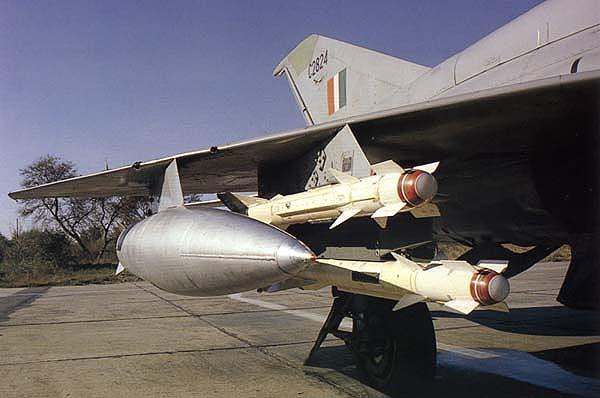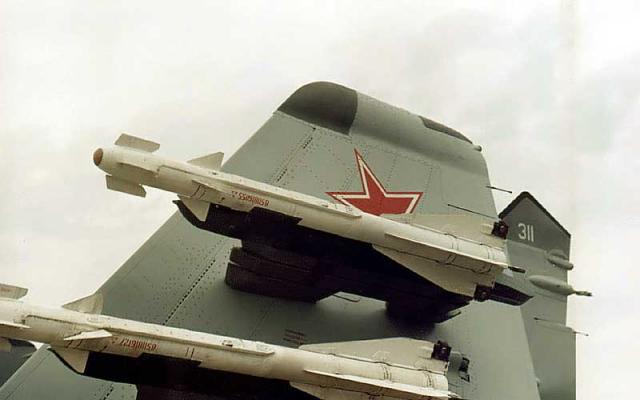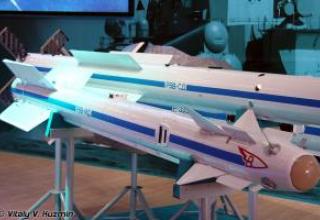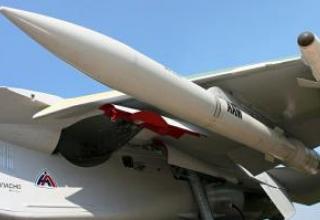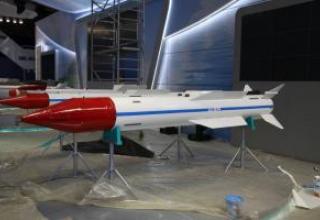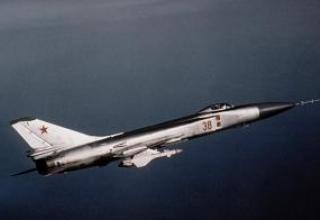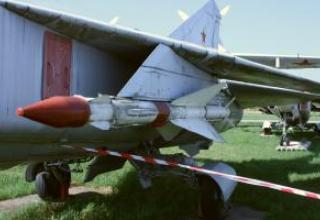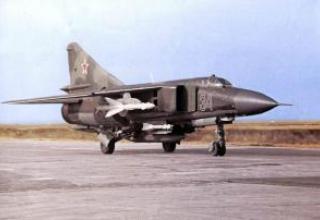Short range missile P-60 (item 62) with heat homing head is designed to engage highly maneuverable manned aircraft and unmanned aerial reconnaissance means in close air battles in the range of visibility.
The R-60 missile was developed by NPO Lightning (General Designer M.R. Bisnovat) in an extremely short time. Natural development of the product from the ground-based missile launcher with pointing to a track mounted on the tower began in 1971. Soon flight tests with the MiG-21 began, and already on December 18, 1973 R-60 was adopted for service.
The high performance of R-60 and thoughtful design of the launchers led to its adoption in service of many combat aircraft: IL-102(R-60M), MiG-21SMT/SM/MM/MF/Bis-I, MiG-23M, MiG-25PD, MiG-27, MiG-29, MiG-31/31M, Su-15TM, Su-17/20/22, Su-24, Su-24M, Su-25, Yak-28PM, Yak-38/38M, Yak-141, Ka-50, Mi-24P/Bis-I, MiG-29, MiG-29, MiG-29.
It was exported to more than 26 countries of the world. The export version is designated P-60MK.
The export version of P-60 was designated as P-60K. The high quality of R-60 was confirmed in the battles between Syrian and Israeli aircraft over Lebanon in 1982. Its launches were marked by hits exactly in the nozzles of enemy aircraft engines.
NATO designation AA-8 "Aphid".
Composition:
P-60 is made according to the aerodynamic scheme "duck" with additional destabilizers in the missile's head part (see diagram). The low launch weight and perfect aerodynamic layout give the missile high maneuverability.
The missile consists of five compartments.
In the first compartment of the missile is a thermal homing head (TGSN) "Komar" (OGS-60TI), developed in the design bureau "Arsenal" under the leadership of SP Alekseenko. TGSN "Komar" was equipped with uncooled photocell and maloinertial coordinator, which provided the development of angles of target designation to 12 ° on the information coming from the airborne sighting system of the aircraft carrier. Angular speed of the target sighting line reached 35°/c, the range of angles of target tracking - 30 ... 35°.
The second compartment contained a rod type combat unit. Fuses - contact and radar. The radius of action of the fuse is 5m.
The third compartment accommodates the safety executive mechanism, the steering drive and autopilot equipment in succession. On the outer surface of the front part of the compartment are installed in pairs kinematically connected aerodynamic rudders, and closer to the tail - antennas of the radio detonator. At the beginning of the fourth compartment there is a radio detonator, and behind it there is a power supply source - two electric generators working from a turbine driven by products of powder pressure accumulator combustion.
The fifth compartment is a solid fuel engine PRD-259 with variable time traction diagram. Triangular wings of large sweeps are attached to the engine body. Small elongation of the wings at a sufficient area for the required maneuverability provides compact placement on the carrier, which is necessary to increase the ammunition. Roller wheels are placed along the rear edges of the wings.
The compartments are connected by a bayonet joint, except for the first compartment, which is fastened by means of a flange joint.
P-60 allows target attack at any initial position in the pilot's field of view within the ±12° target designation angle range and at angular velocities of the target sighting line up to 35°/s. Target flight speed up to 2500 km/h in the range of heights from 30 m to 20 km.
The upgraded version of the missile - P-60M - features an extended up to ± 20° range of target designation angles, increased up to 3.5 kg weight of combat unit and the use of a more advanced homing head "Komar-M" with a cooled photoreceiver. The Komar-M cooled photoreceiver has increased the head sensitivity and made it possible to use the P-60M missile in the front hemisphere of the target in close maneuverable combat, which significantly increases the combat potential of the carrier aircraft. The calculated probability of hitting a single P-60M target in close range is 0.9.
It is used with R-60 (R-60-I), R-60-II (P-62-2, dual suspension unit) and PD-62 (on Su-15TM) launchers. For educational purposes it is used UZR-60 (training and recording with the registrar).
The missile is delivered to the troops fully assembled, in hermetic and wooden packaging, protecting against mechanical damage.
Characteristics:
| Start weight, kg: | ||
| - R-60 | 43.5 | |
| - R-60М | 44 | |
| The weight of the combat unit, kg: | ||
| - R-60 | 3 | |
| - R-60М | 3.5 | |
| Launch range, km: | ||
| - low | 0.25-1.5 | |
| - high | 0.50-8 | |
| Missiles flight speed | 2.5-3М | |
| Maximum starting overload, g | 7 | |
| Maximum overload, g | 47 | |
| Time of controlled flight, s | 23 | |
| Overloading of affected targets | 12 | |
| Dimensions, mm: | ||
| - length R-60 / R-60M | 2095 / 2138 | |
| - case diameter | 120 | |
| - plumage scale | 390 | |
Testing:
R-3C was baptized in battle in Vietnam and then in the Middle East. It proved to be a good weapon, unpretentious and reliable. However, TGSN R-3S was sensitive to weather conditions (rain and cloud cover absorbed infrared radiation), the attack was possible only from the rear hemisphere, and to evade it, the enemy used to evade the sun - a powerful natural source of heat (at night such a false target could be a "cold" moon). The launch performance was also affected by the missile's limited maneuverability when flying to the target, its inability to descend from the track at high overloads in combat and insufficiently powerful combat unit. The area of possible attacks was also reduced by the minimum allowed range (it was determined by the inability of the TGSN to track the target moving fast on azimuth and its own safety in case of a BC explosion).
For 1966. - the first year of use of R-ZS missiles in Vietnam, they were hit by 16 out of 57 American aircraft shot down by fighter aircraft. Their efficiency was 35% at 46 launches. Skills and more careful observance of tactical recommendations allowed next year to increase the effectiveness of missile attacks: in 53 battles MiG-21 shot down 50 planes. The overwhelming majority of R-3C launches were carried out from behind at short ranges (1200 - 2500m), only 5% of the attacks were carried out from distances over 2500m.
Shortcomings in training and tactics affected the use of missiles in the Middle East battles: sharp maneuvers of impulsive Arab pilots who did not comply with the prescribed modes of launch, led to unsuccessful launches and wasted missiles. Thus, in the group battle on November 3, 1968, the price of victory over two Israeli "Mirages" was 13 spent by the Egyptians R-3C. In the Indo-Pakistan conflict in December 1971, out of 10 victories won by Indian MiG-21, 8 were achieved with the use of guns and only 2 with the launch of R-3C.
Sources:
- В.Марковский, К.Перов. Развитие советских авиационных ракет класса "воздух-воздух".М-Хобби.

